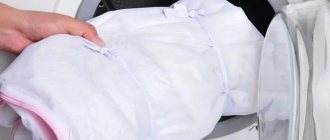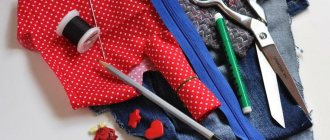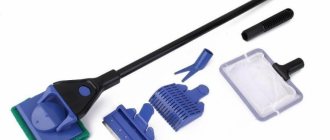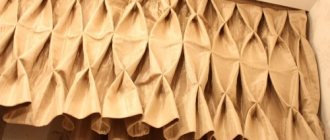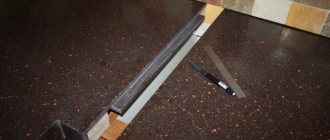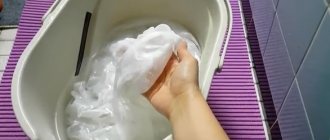Not always ready-made curtains correspond to the length you need, and sometimes there is a desire or need to sew curtains yourself from the fabric you like. How to hem the tulle correctly, process the edges and top so that the curtains look beautiful and elegant?
There is nothing complicated in such work. To hem curtains, you will need a sewing machine, a minimum set of tools and materials: threads, needles, scissors. Also, keep an iron handy while working - you will have to press hems and seams after each line.
Textile
Often tulle is called not only the fabric itself, but also all light transparent curtains. They can be made of tulle or other materials - most often organza, less often viscose and cotton.
Before you start working with light synthetic fabric (tulle, organza), carefully examine the fabric and determine how the grain thread runs. You need to cut the fabric along it. Before trimming the edges, they must be steamed with an iron.
If your material is tulle, then to make it easier to navigate, you can pull one thread from the fabric at a distance of 0.5-1 cm from the edge, and then cut along the line formed. This trick won’t work with any other fabric—you’ll have to trim it without a guide.
Synthetic tulle is very slippery, so each edge is aligned one at a time. It is advisable to place thick cotton fabric under the material so that it slips less.
How to wash tulle in a washing machine: loading features, temperature and washing modes
Before putting the tulle into the drum, you need to carefully fold it - if you load the fabric in a crumpled form, after washing there will be creases on it. If we are talking about muslin, veil, thin organza with embroidery and other particularly delicate fabrics, it is better to place neatly folded curtains in a special mesh bag for washing - this will not interfere with washing, but will save the fabric.
Tulle is washed in a delicate wash mode - at a temperature of 30° and without spinning . During this type of washing, the drum of the machine rotates more smoothly, and washing occurs with a large amount of water - this minimizes the risk of damage to thin fabric. You can wash tulle curtains on the silk and wool cycles - they are as gentle as possible.
When loading laundry detergent into the machine, be economical . In most cases, housewives add powder or shampoo for washing generously, from the heart. In the case of washing tulle, this can lead to increased foaming, especially if mesh fabric is sent in the wash. Therefore, check the dosage recommended by the manufacturer and, since the fabric is light and the machine operates with an incomplete load, reduce the dose by half.
When washing curtains, it is advisable to use the extra rinse function : detergent residues also lead to premature yellowing of the fabric.
After finishing the washing cycle, you need to remove the tulle from the machine, let the water drain and, without squeezing it, hang it on the curtain rod. If the curtain is voluminous, you can lightly squeeze it out manually, with very light movements, without twisting.
Once dry, the fabric will straighten under its own weight. You can iron tulle only in the most extreme cases, and very carefully - this also leads to yellowing of the fabric.
Threads and needles
For tulle and organza, select thin threads of size No. 40 and smaller. Their color should be in harmony with the color of the fabric. If the material shimmers, then take threads that are a couple of shades lighter - light does not stand out so much against a dark background.
Thin needles are inserted into the machine. They must be sharp, since tulle is a very delicate material, it is easily pulled and torn.
General rules for washing tulle
Tulle requires delicate care - even if we are talking about inexpensive nylon mesh curtains. This fabric cannot withstand high temperatures - too hot water or an iron can cause the fabric to turn yellow. Therefore, tulle is washed in lukewarm water and try not to iron.
At the same time, the curtains do not require intensive washing - dirt comes off the fabric quite well, especially if you do not “start” the process. Tulle curtains need to be washed once every 3-4 months - in this case, maintaining their whiteness will be quite easy. But, if we are talking about kitchen curtains, if the windows face a busy highway, or if family members are allergic to dust, it is better to increase the frequency of washing.
Since dust usually accumulates on curtains, it is advisable to shake out the tulle on the balcony or outside before washing. In this case, washing will be more effective.
Preparatory work
Before work, cover the table with a cotton cloth - this will reduce the sliding of the curtain on the surface.
It is recommended to hem very thin material on tissue paper. After completing the stitch, the paper simply comes off.
Before you start working on your sewing machine, stitch a little on a small unnecessary piece of tulle. If necessary, adjust the stitch length and thread tension. The seams are made with a straight stitch with an average step length (3-4 mm).
We recommend: Blood on the sofa: how and with what to remove it so that no traces remain
How to cut and shorten tulle evenly if it is long?
Nowadays, more and more buyers do not trim curtains, but use a variety of hems. This will allow you to rip off the tape and lengthen the curtains if necessary. But if you do not want to do this, it is advisable to shorten the tulle after it has hung on the curtain rod for 3 days. In this case, the canvas is completely straightened.
Instructions:
- Once your curtains have hung, you can trim them.
- To do this, it is worth considering the features of your room. Often the floor and ceiling are curved, which is why the height of the room is different at certain points.
- In this case, it is worth noting the height at the beginning, at the end and in the middle. After that, print the average value.
- It is advisable to draw a line using a ruler. Often curtains are cut using a stationery knife.
- To do this, the ruler is placed on the curtain and drawn with a knife.
How to cut and shorten tulle evenly if it is long?
Side edges
First we process the side edges of the curtain.
- The edge should be trimmed evenly and smoothed.
- We place the tulle with the wrong side up, fold the hem 1-2 cm. Smooth it with an iron.
- Then fold the edge again by 1-2 cm and iron it. This way we get a double hem.
- To make the material slip less, you can fix it with pins before ironing.
- We sew the seam on the machine at a distance of approximately 1-2 mm from the edge of the hem.
We process the second side edge of the curtain in the same way.
Processing curtains, tulle or organza with a zigzag stitch
When processing the cut edge of a curtain with a zigzag stitch, bend the edge of the tulle or organza by at least 1 cm.
Iron the hem of the curtain; this way it will be easier for you to sew a zigzag stitch.
Before hemming curtains in this way, you need to adjust the thread tension of the sewing machine, the length and width of the stitch. Take a piece of organza or tulle and make a prototype.
This kind of neat and beautiful scar should be obtained by processing the cut edge of tulle or organza in this way.
Now take sharp, thin-bladed scissors (you can use nail scissors) and carefully cut off the excess tulle so as not to damage the main fabric of the curtain.
This is what a curtain processed with a zigzag will look like on the wrong side of organza.
The right side of the folded edge of the chiffon is finished with a zigzag.
Video on how to hem a dress or skirt made of chiffon. The video is in English, but understandable without words; you can turn on subtitles in the language you need.
How to hem to length?
Some curtains have beautiful trim at the bottom - lace, scallops, original patterns. Sometimes weights are inserted into the tulle - a special cord or weights. In this case, the curtain length is adjusted only when processing the upper edge.
If the bottom of the fabric is simple, then it can be hemmed in several ways. The simplest is a double hem, the same as on the sides of the canvas.
The width of the hem is slightly larger than on the sides, and depends on the material of the curtain.
- In rigid fabrics (nylon, organza), the fold width should be at least 3 cm.
- The veil and light tulle can be folded up to 2 cm.
- It is recommended to hem plastic mesh to a width of 1 cm.
More difficult to perform are the Moscow seam (American) or bias tape.
On a note
It is not recommended to process the bottom of curtains made of light fabrics with a zigzag or overlock stitch - this will make the fabric fit and drape worse.
Moscow seam
How to hem organza curtains and tulle correctly? A good way is the so-called Moscow seam.
It is performed as follows.
- Fold the edges of the curtains 0.5-1 cm and iron them.
- Perform a straight stitch at a distance of 2-3 mm from the edge of the hem.
- Excess fabric of the hem is cut off at a distance of 2-3 mm from the stitching. The material should not crumble.
- Fold the fabric over again, iron it and stitch it. They try to get into the first line or make a seam at a distance of 1-2 mm from it. In this case, the first seam remains inside the hem.
In this way, a light, airy curtain edge is obtained with minimal material consumption for the hem.
Bias tape
This method is most often used to process embroidered fabric or mesh tulle.
For this you will need a special foot, which comes with your sewing machine. It can also be purchased at sewing stores. A snail foot would also work. The bottom of the curtain is trimmed evenly, ironed and folded when sewing (the edge of the fabric is tucked into the foot).
We recommend: How to avoid flooding your neighbors after installing a heated towel rail: common causes of leaks and tips for eliminating them
Bias tape can be purchased at the store. This is an applied tape with pre-fitted allowances; it can serve a decorative function (for example, satin trim). It's easy to sew on.
- Pin the binding to the bottom edge of the tulle with sewing pins.
- Check the joints.
- Sew with a straight stitch.
Determining the required length
In order for the result to be positive, it is important to correctly determine the length of the tulle, which will soon decorate your windows, creating a unique atmosphere of comfort, warmth and coziness in the house.
When the sides are already aligned, it is important to correctly, taking into account the allowances, give the tulle the required length. If you need to hem the bottom of the tulle, the steps are similar. Measure 14 cm from the bottom of the fabric and pull out the thread. Having done this, you will see a straight line along the length of the entire edge.
- Measure the length. If you follow the basic rules, it is important to know that the curtain should have a length that is 10-15 centimeters shorter than the total length from the cornice to the floor. A curtain of this length opens easily and does not collect dust from the floor.
- Make marks (with soap, pencil or chalk) on the fabric surface.
- Cut off the remaining fabric.
Important
Make it a straight, even line. If you are not sure of your own eye, draw a straight line.
Are all the steps listed already behind you? Check again to see if everything was done correctly. If everything is correct, proceed to the next steps.
Related article: If the drum in a Bosh washing machine does not spin
Trimming thread curtains
Thread curtains are very difficult to trim, given the peculiarity of this type of curtain. Their peculiarity is that the curtains consist of a large number of vertical lines that are not connected to each other in any way. This greatly complicates the circumcision process.
As in previous cases, you initially need to lay the curtains on a flat surface, straighten the threads as much as possible so that they are on the same level. After this, you need to apply a mark along which you will subsequently need to cut. Given the nature of the curtains, it will be impossible to apply a mark with a regular pencil or pen.
It is recommended to press the curtains down with a board as evenly as possible, and cut them with a utility knife. This will allow you to shorten this type of curtain as smoothly and accurately as possible.
It will not be possible to process the edges, given the features. The photo of trimming thread curtains shows that later, most likely, it will be necessary to adjust the length in some places.
